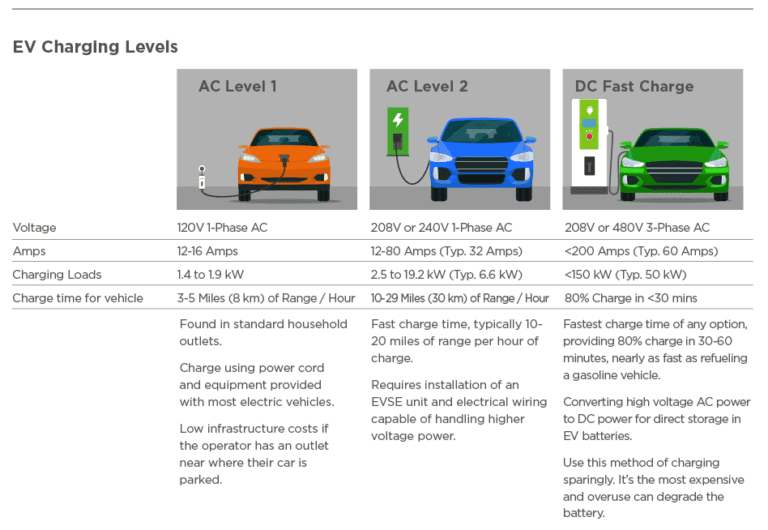The availability of sufficient infrastructure to power EVs is a critical factor in the expansion and adoption of EV technology. While there are many factors that influence charging infrastructure development, improved battery technology is key. Which is why a lot of investment has been made to enhance battery technology. In fact, EV ranges have more than doubled from the last decade, helping to relieve range anxiety.
EV range and charging infrastructure are converging technologies that will reduce the barrier to adoption for many fleets. As range extends, the need for pervasive charging infrastructure on every corner becomes less important. As infrastructure improves, the need for expansive range capabilities on vehicles becomes less important.
Below is a collection of FAQs to help you understand these important concepts.
Q: What types of charging infrastructure are available for fleets?
A: There are four types of infrastructure:
- Public: Most analogous to gas stations today, these are locations EV drivers would access while out.
- Residential: While no one (or at least very few) has a gas pump in their driveway, many will have access to efficient vehicle chargers while parked at home.
- Depot: When several fleet vehicles “rest” at the same place each night (or day, depending on their application), this is considered a depot. A depot will need to be capable of charging many EVs concurrently, or on a set schedule.
- Workplace: Many companies will have charging infrastructure at their corporate locations, available to employees as a perk. If fleet drivers have access to these, this is another opportunity to effectively charge their EV.
Q: What are the different levels of charging?

Q: Is all infrastructure universal?
A: No, there are a few proprietary networks and plug types that are not interoperable.
For Level 1 & 2 charging, the most common connector is the SAE J1772 EV plug. All EVs in Canada and in the U.S. can charge using this plug, including Tesla vehicles, when using an adapter. The J1772 connector is available for Level 1 and 2 charging.
For fast charging, the CHAdeMO and SAE Combo (also called CCS for “Combo Charging System”) are the most used connectors by electric cars manufacturers. These two connectors are not interchangeable, like how gasoline vehicles cannot use a diesel pump at a fuel station.
The third connector is the one used only by Tesla. That connector is used on Level 2 and 3 Supercharger Tesla stations.
Q: How is EV range measured?
A: Like fuel economy on conventional vehicles, EV range is measured under specific conditions. As always, real world conditions will impact range, including temperature, battery age, and driving habits.
To measure and establish a vehicle’s EV range, automakers around the world rely on one of three testing standards. They include the New European Driving Cycle (NEDC), Worldwide Harmonised Light Vehicle Test Procedure (WLTP), and the Environmental Protection Agency (EPA) test.
The NEDC and WLTP focus primarily on urban and suburban travel in achieving their estimates because that is the type of driving most Europeans encounter. The WLTP system, introduced in 2017, is replacing the NEDC methodology. The EPA emphasizes highway driving since Americans spend more time on interstates, whether they are commuting to work or traveling long distances for recreational reasons.
Q: How much range do I need?
A: It depends. Ideally, you should select a vehicle with a range sufficient for the job it needs to accomplish. That does not necessarily mean that 100% of trips can be done on a single charge, as drivers may have the ability to charge during their travel. Having a good understanding of individual vehicle usage – whether via telematics or from information gathered directly from the driver – will help you best identify the necessary range. In the event there is not a BEV that can address your range needs, a PHEV may be a good option. Or, having access to an ICE vehicle for those exception trips can allow you to move ahead with EV adoption while still ensuring individuals can make the trips necessary for their role.
Up Next